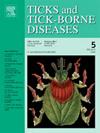Theileria annulata infects B-cells in sheep, which display lower dissemination potential compared to T. lestoquardi-infected ovine B-cells
IF 3.4
2区 医学
Q2 INFECTIOUS DISEASES
引用次数: 0
Abstract
Theileria annulata and Theileria lestoquardi are deadly tick-borne parasites of cattle and sheep, respectively. These parasites are transmitted by Hyalomma ticks, and their geographical distributions partially overlap, with T. annulata having a wider range. Theileria lestoquardi infection is highly pathogenic in its natural sheep and goat hosts while T. annulata infection usually causes a mild disease in these species. Interestingly, T. annulata does not produce merozoites/piroplasms in sheep and goats, therefore it is not tick-transmissible. The aim of the current study was to understand the basis of the attenuated pathogenicity of ovine infections by T. annulata. Theileria annulata and T. lestoquardi sporozoites were used to infect sheep and parasitized ovine leukocytes were isolated and phenotyped. This revealed that T. annulata sporozites target ovine B-cells, whereas T. lestoquardi sporozoite infection was not restricted to ovine B-cells. The ability of ovine B-cells infected with T. lestoquardi or T. annulata to traverse Matrigel in vitro was investigated, as a surrogate for their ability to disseminate in vivo and cause disease. The Matrigel traversal index of T. lestoquardi-transformed ovine B-cells was significantly higher than that of T. annulata-transformed ovine B-cells isolated from the same host, consistent with the reported diminished pathogenicity of T. annulata infections in sheep. Theileria lestoquardi-transformed ovine B-cells preferentially expressed matrix metalloproteinase 2 (mmp2), whereas T. annulata-infected ovine B-cells strongly expressed mmp9. Correspondingly, MMP9 protein levels and collagenase activity were higher in T. annulata-transformed ovine B-cells. However, T. annulata-transformed ovine B-cells expressed higher levels of transcripts for Tissue Inhibitor of Metallopeptidases 1 and 2 (TIMP1 and TIMP2). TIMPs are the natural endogenous inhibitors of MMPs. This argues that their heightened expression could underpin the significantly lower Matrigel traversal activity of T. annulata-infected compared to T. lestoquardi-infected ovine B-cells.
环状沙雷氏菌感染了绵羊的 B 细胞,与感染 T. lestoquardi 的绵羊 B 细胞相比,环状沙雷氏菌的传播潜力较低。
环芽肠杆菌和鼠口肠杆菌分别是牛和羊的致命蜱传寄生虫。这些寄生虫由透明体蜱传播,它们的地理分布部分重叠,其中环纹蜱的分布范围更广。lestoquardi肠杆菌感染在其天然宿主绵羊和山羊中具有高致病性,而环纹肠杆菌感染通常在这些物种中引起轻度疾病。有趣的是,环锥虫在绵羊和山羊中不产生分殖子/梨质体,因此它不会被蜱虫传播。本研究的目的是了解猪环绦虫感染的减毒致病性的基础。利用环孢杆菌和lestoquardi孢子虫感染绵羊,分离出被寄生的绵羊白细胞并进行表型分析。这表明环孢霉孢子虫感染的对象是羊b细胞,而莱斯托quardi孢子虫感染的对象并不局限于羊b细胞。研究了感染了lestoquardi或T. annulata的羊b细胞在体外穿越母体的能力,以此作为它们在体内传播和致病能力的替代。lestoquardii转化的羊b细胞的Matrigel穿越指数显著高于从同一宿主分离的环形t转化的羊b细胞,这与报道的环形t感染在羊中的致病性降低相一致。鼠笼杆菌转化的羊b细胞优先表达基质金属蛋白酶2 (matrix metalloproteinase 2, mmp2),而环纹t菌感染的羊b细胞强烈表达mmp9。相应的,MMP9蛋白水平和胶原酶活性在环孢霉转化的羊b细胞中较高。然而,环孢霉转化的羊b细胞表达了更高水平的组织金属肽酶抑制剂1和2 (TIMP1和TIMP2)转录本。TIMPs是天然的内源性MMPs抑制剂。这表明,它们的高表达可能是环形t细胞感染的羊b细胞与lestoquardii感染的羊b细胞相比,基质穿越活性显著降低的原因。
本文章由计算机程序翻译,如有差异,请以英文原文为准。
求助全文
约1分钟内获得全文
求助全文
来源期刊

Ticks and Tick-borne Diseases
INFECTIOUS DISEASES-MICROBIOLOGY
CiteScore
6.90
自引率
12.50%
发文量
185
审稿时长
6-12 weeks
期刊介绍:
Ticks and Tick-borne Diseases is an international, peer-reviewed scientific journal. It publishes original research papers, short communications, state-of-the-art mini-reviews, letters to the editor, clinical-case studies, announcements of pertinent international meetings, and editorials.
The journal covers a broad spectrum and brings together various disciplines, for example, zoology, microbiology, molecular biology, genetics, mathematical modelling, veterinary and human medicine. Multidisciplinary approaches and the use of conventional and novel methods/methodologies (in the field and in the laboratory) are crucial for deeper understanding of the natural processes and human behaviour/activities that result in human or animal diseases and in economic effects of ticks and tick-borne pathogens. Such understanding is essential for management of tick populations and tick-borne diseases in an effective and environmentally acceptable manner.
 求助内容:
求助内容: 应助结果提醒方式:
应助结果提醒方式:


